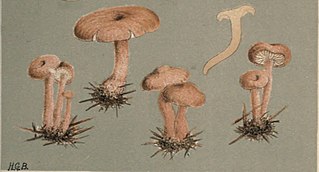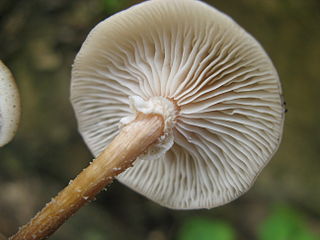
Armillaria is a genus of fungi that includes the A. mellea species known as honey fungi that live on trees and woody shrubs. It includes about 10 species formerly categorized summarily as A. mellea. Armillarias are long-lived and form the largest living fungi in the world. The largest known organism covers more than 3.4 square miles (8.8 km2) in Oregon's Malheur National Forest and is estimated to be 2,500 years old. Some species of Armillaria display bioluminescence, resulting in foxfire.

Armillaria socialis is a species of fungus in the family Physalacriaceae. It is a plant pathogen. Originally described by Augustin Pyramus de Candolle in 1815, it was transferred to Armillaria by Victor Fayod in 1889. It is found in Asia, Europe, and North America.
Armillaria apalosclerus is a species of mushroom in the family Physalacriaceae. This species is found in Asia.
Armillaria affinis is a species of agaric fungus in the family Physalacriaceae. This species is found in Central America.
Armillaria camerunensis is a species of agaric fungus in the family Physalacriaceae. This species is found in Africa.
Armillaria duplicata is a species of mushroom in the family Physalacriaceae. This species is found in Asia.
Armillaria fellea is a species of mushroom in the family Physalacriaceae. This species is found in Australia.
Armillaria fumosa is a species of mushroom in the family Physalacriaceae. This species is found in Australia.
Armillaria melleorubens is a species of mushroom in the family Physalacriaceae. This species is found in Central America.
Armillaria montagnei is a species of agaric fungus in the family Physalacriaceae. This species is found in Australia, Europe, New Zealand, and South America.
Armillaria omnituens is a species of mushroom in the family Physalacriaceae. This species is found in Asia.
Armillaria pallidula is a species of mushroom in the family Physalacriaceae. This species is found in Australia.
Armillaria pelliculata is a species of agaric fungus in the family Physalacriaceae. This species is found in Africa.
Armillaria procera is a species of agaric fungus in the family Physalacriaceae. This species is found in South America.
Armillaria singula is a species of agaric fungus in the family Physalacriaceae. It is found in Asia.
Armillaria tigrensis is a species of mushroom in the family Physalacriaceae. This species is found in South America.
Armillaria viridiflava is a species of agaric fungus in the family Physalacriaceae. This species is found in South America.
Armillaria yungensis is a species of agaric fungus in the family Physalacriaceae. This species is found in South America.

Armillaria puiggarii is a species of agaric fungus in the family Physalacriaceae. This species is found in Central and South America.


